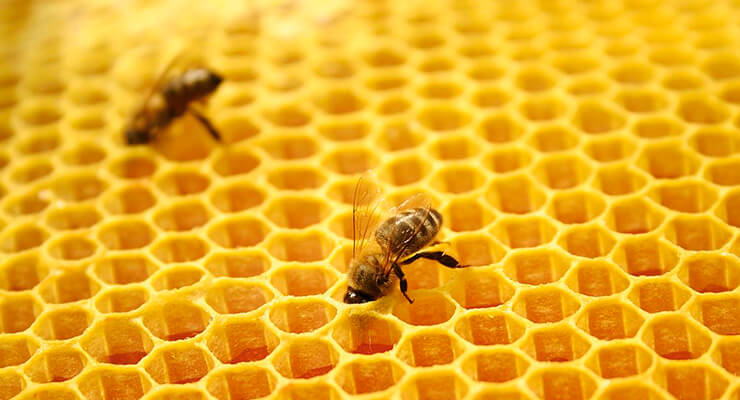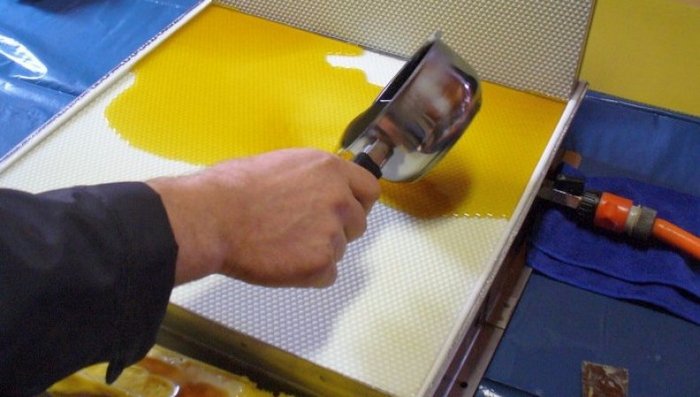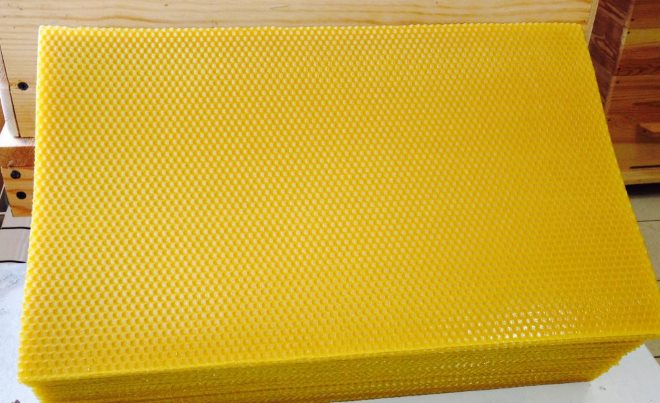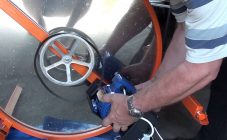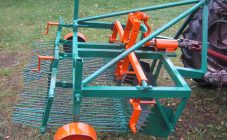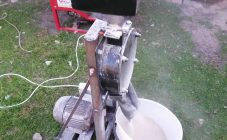Content:
Foundation - a wax sheet that is used to equip the hive. Required to improve the health, fertility of the bee colony. The released base will free the insects from the need to build a home, and they will concentrate on collecting pollen (pollen) and nectar. Beekeepers are interested in how to make foundation with their own hands.
Making foundation
Self-production of foundation is rare. But it is quite easy to start a line for the production of foundation at home.
In the manufacture of waxes, methods are used: a press or rollers.
Do-it-yourself rolls for foundation include 2 drums with a prepared honeycomb pattern. Passing the sheet through the mechanism is distinguished by the extrusion of the bottoms. Some beekeepers make rolls themselves for foundation, but it is advisable to use a press at home.
At times, bee land owners prefer plastic foundation - a sheet of plastic with extruded cells that resemble honeycomb bottoms. Often suitable for expanding nests with foundation.
Advantages of artificial foundation:
- strong;
- does not deform;
- easy to store;
- service life - within 10 years;
- microorganisms do not settle;
- there is no need for naschivanie.
Plastic protects against pests: wax moth, rodents.
Negative sides:
- periodic sanitization from harmful microflora;
- waxing before installation;
- cannot be repaired.
However, Russian beekeepers buy plastic honeycombs cautiously, they think that the product is unsafe and spoils honey. Although the product is popular with consumers in the US.
Agrarians of Russia give preference at the everyday level to the Scythian method, the action of which is based on the rejection of stamps and rollers.
Ease of admission lies in the use of available means for the manufacture of foundation:
- melted wax;
- waxed paper;
- non-woven fabric.
Foundation machine
The machine for the production of factory-made foundation has 2 weighted plates that are fastened between themselves with a specific thickness with a lumen and with a convex surface in the form of hexagonal microcells.
To make it easier to remove the finished foundation, the press is moistened from the inside with water, then the wax is poured. Such a device is suitable for a non-professional apiary due to its low productivity.
Mount foundation machine at home will not be difficult:
- for the construction of a matrix with prepared cells, the foundation plate is covered with a solution: silicone or gypsum, cement or epoxy resin;
- after hardening of one side, the planes are carefully separated, the wax traces are eliminated with hot liquid;
- reproduce the procedure and attach the manufactured matrices to metal plates;
- then bonded together so that the finished sheet differs in the planned thickness after curing.
Home bee wax
The machine that produces the foundation is called the rolls. The tool can be found in retail outlets or built with your own hands.The complexity of the mechanism lies in the embossed surface: the dimensions of the cells must match the dimensions of the honeycomb, which bees do.
The main components of the design include:
- 2 engraved drums that are coated with a polymer compound to prevent wax sticking;
- adjustable bolts to shorten or lengthen the spacing between shafts;
- 2 gears that give the rollers a translational rotation;
- a base that serves as a mount for other items of equipment.
The initial stage in rolling wax sheets is the release of blanks.
There are two main ways:
- Pouring into pre-prepared forms. Purified and dissolved wax is poured into prepared molds with wooden rims, which are moistened with water ahead of time. After hardening, the finished sheet is passed through the machine. At the exit, the workpiece is thicker than the specified value, because the sheet is similar to a tape, which is later brought to the standard.
- Covering the sheet with wax. The wetted plywood sheet is placed several times in liquid wax. When they want to get a thin sheet - two, if thicker - more. After cooling, two sheets are removed and driven through the rollers. Such a workpiece comes out thinner: based on the size of the mold, the dimensions of the final product are adjusted. The resulting trim is to a minimum.
Equipment
Do-it-yourself foundation and its creation will not require purchasing expensive special equipment. Press and hand rollers can be purchased.
Requirements for the selection of devices:
- high quality and safe texture;
- aluminum rollers and work space are coated with tin and nickel;
- purchase of prepared forms;
- purchasing a cooling system to preserve the honeycomb structure;
- the principle of the machine for wax - a waffle iron: pressing molten wax between two strips with dies.
The correct choice of design affects the technological process: it reduces the time for the manufacture of each wax sheet.
The release begins with the calculation of the wax required for the production of plates. Calculations are carried out individually.
Production
Technological processes for the production of plates are carried out in stages at home:
- Melt the wax, filter the liquid mass from impurities, debris.
- Set humidity. When the indicator is more than 2%, the liquid is evaporated over low heat.
- Melt over steam using two tanks. Pull out the prepared sheet, throw it over the side of the bath.
- Pass the sheet between the rollers. Wax adhesion is prevented by pre-cooling.
- It is just right to dry the foundation plates under normal conditions.
The disadvantage of self-production is the beekeeper's time consumption, which removes from business. But the automation of your workshop will significantly reduce the time for processing wax.
Silicone matrix for foundation
The main component of the device is the foundation matrix. It is a frame that holds the delicate mechanism made from natural beekeeping products.
The design is characterized by:
- strength;
- glossy surface;
- first-class texture without harmful impurities.
Inconsistency with the rules in response to harm to the well-being of Hymenoptera and defects in honey beekeeping products that are stored and matured in prepared combs.
Many beekeepers use a silicone matrix for the foundation.
Some beekeeper owners believe that the distinguishing features of silicone products are softness and instability.
This problem is solved by adding a small amount of building ceramics to the matrix. They increase the service life of the matrix and give a pleasant appearance, thanks to auto paint for additional coating.
It is appropriate to use varnishes instead of car paint. They are applied to the matrix with a brush or spray, spraying evenly over the surface.
Silicone matrices are like rubber. It is useful to adhere to the dimensions of the device for the tight entry of the sheets of wax with cells into the structure. In addition, the size of the matrix should correspond to the hive where the installation is planned to avoid breakages during use by bees.
Technological process
To make a matrix with your own hands, you will need:
- 600 ml of silicone;
- putty knife;
- 40 g of catalyst;
- Scotch;
- natural or artificial foundation.
First, a base is placed on a hard, flat surface. Adhesive tape will help out in the manufacture of the board, which will protect against leakage of silicone. Then the catalyst is mixed in and poured into a mold. When hardened with a spatula, they take out the finished product.
Today manufacturers offer matrices of various sizes. In addition, the do-it-yourself foundation matrix is cast at home, taking into account individual properties.
To install the frame in the hive, wax is heated and applied in a small amount over the equipment. When the shelf life of the product ends, it is melted with a special wax melter.
Beekeeping cannot be imagined without foundation. Wax sheets increase efficiency and health of bee colonies. The production of wax plates at home is easy to implement. It will take elementary special equipment, time, experience.
